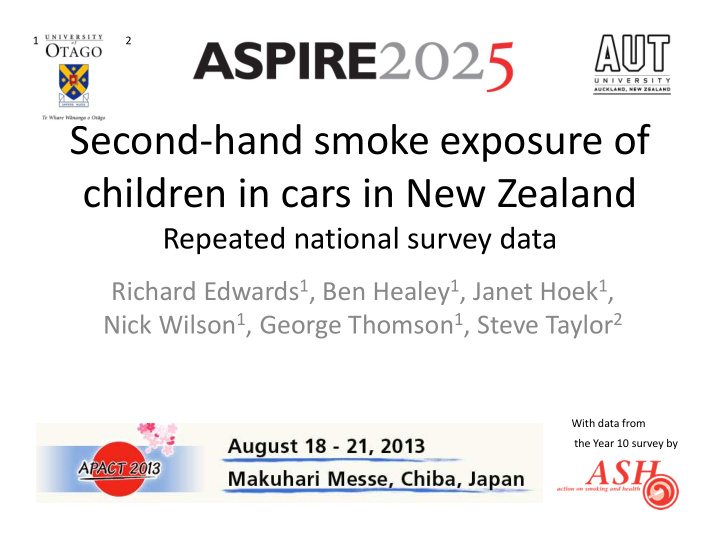



1 2 Second-hand smoke exposure of children in cars in New Zealand Repeated national survey data Richard Edwards 1 , Ben Healey 1 , Janet Hoek 1 , Nick Wilson 1 , George Thomson 1 , Steve Taylor 2 With data from the Year 10 survey by
New Zealand’s location
ASH ‘Year 10’ Snapshot Survey • All Year 10 (14-15 years) school students invited to participate • Over 25,000 participate each year • Sample representative of NZ population of Year 10 students • Analyses weighted by ethnicity and SES, standardised to age distribution in 2007
“ During the past 7 days, did anyone smoke in your “ presence while you were travelling in cars or vans?
Exposure to secondhand smoke (SHS) in vehicles or in the home 2006-12 Note: Figures weighted by age, ethnicity and socio-economic status. Confidence intervals adjusted for clustering at school level.
23% of 2012 respondents... Just under 14,000 14-15 year old students... 350 bus-loads per week. …and that’s only the 14 -15 years old students It is likely over 100,000 children are exposed per week Note: Assuming 40 seats per bus
Māori and Pacific youth had higher risk of exposure
Youth with lower socio-economic status youth had higher risk of exposure
Smoking prevalence in social network greatest predictors of exposure Adjusted odds ratios, by year Variable Effect 2006 2007 2008 2009 2010 2011 2012 Age 15 years vs 14 years 1.1 1.1 1.0 1.1 1.1 1.2 1.1 Sex Female vs Male 1.1 1.1 1.1 1.0 1.0 1.1 1.1 Ethnicity Maori vs NZ European 1.3 1.3 1.3 1.3 1.3 1.4 1.4 Pacific vs NZ European 1.3 1.3 1.3 1.2 1.6 1.5 1.4 Asian vs NZ European 0.8 0.8 0.9 1.0 1.0 1.0 1.0 Other vs NZ European 1.2 1.4 1.3 1.6 1.6 1.4 1.2 SES Low vs High 1.6 1.3 1.5 1.6 1.5 1.4 1.5 Medium vs High 1.3 1.2 1.4 1.3 1.2 1.3 1.3 Parents Smoke Both vs Neither 9.1 9.7 7.9 7.5 8.4 8.0 7.4 One vs Neither 4.6 4.7 4.1 3.8 4.1 4.3 3.9 Sibling Smokes - 1.9 1.9 2.0 2.0 1.9 1.9 1.8 Friend Smokes - 2.3 2.4 2.3 2.2 2.2 2.4 2.3 Note: Analysis weighted for age, SES, ethnicity. Adjusted for clustering. Adjusted odds ratios with a grey background were not significantly different from 1 (95% confidence level).
Of those reporting they were exposed... On how many days during the week did it happen?
Developments around smokefree vehicles in NZ • Only mass media campaigns on the SHS hazard to date • A 2010 Māori Affairs select committee recommended extending smokefree laws to vehicles • Substantial support among public and smokers for policies to protect children in cars from • A Government Minister and Māori political leader has expressed Support for a new law Tariana Turia, Associate Minister of Health & Māori Party Leader 11
Conclusions • Smoking in cars remains an important source of SHS exposure for youth in New Zealand • Ethnic and SES disparities in exposure contribute to health inequalities • These results contribute to the strong justification for smokefree cars legislation – consistent with jurisdictions in Australia and North America
Further information? Please contact: Prof. Richard Edwards, Department of Public Health, University of Otago, Wellington Email: richard.edwards@otago.ac.nz http://aspire2025.org.nz/ Promoting “ auahi kore ” (smokefree in Māori language)
Note: Slide here for use if necessary only. Response by year Year Population Responses % Popn. 2006 63,086 32,841 52% 2007 62,018 25,978 42% 2008 61,485 30,872 50% 2009 61,355 25,762 42% 2010 61,212 32,605 53% 2011 59,562 26,645 45% 2012 59,627 28,447 48% School participation ranged from 44% to 58% More than 230 schools participated each year.
Recommend
More recommend